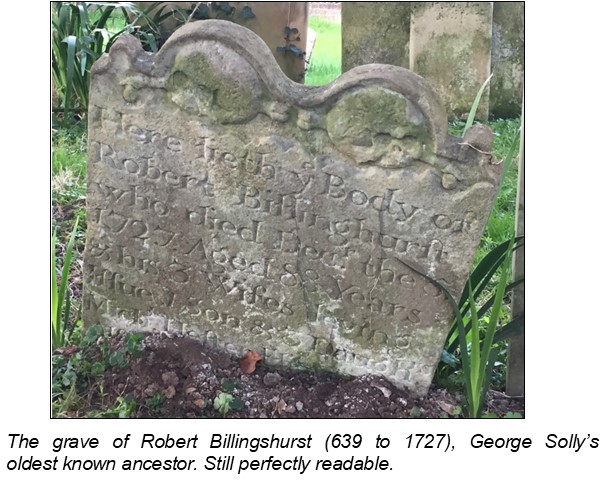By George Solly
This article was published in the August 2017 edition of Soul Search, the Journal of The Sole Society
Occasionally I get to do ‘live’ family research when my wife travels around the country, training teachers at conferences and workshops. Being semi-retied I am able to do the driving and IT support for her and if the conference location fits I can indulge in hands-on Solly research. Recently we have been to Richmond several times in furtherance of her Froebel training which gives me the opportunity to take the bus to Kew for the National Archives. With the easily-acquired readers’ ticket I have been able to look at original Solly documents going back over three centuries. However much of what I need is lodged in county archives so a recent trip to Whitechapel allowed me to visit the London Metropolitan Archives in Clerkenwell to examine the fate of the Essex Sollys who migrated to London about 120 years ago. Unhelpfully some relevant records are missing due to the transfer of parts of south west Essex to Greater London in the late Victorian period (the same applies to north west Kent) so visits to county archives at Chelmsford and Maidstone respectively are necessary. Being in London overnight the next day I visited Tower Hamlets Local History Library and Archives where I was able to trace the Solly family’s Billingsgate wholesale fish business from 1907 to 1953 through the archive’s extensive collection of Kelly’s / Post Office guides.
Being in Whitechapel I was curious as to the current owners of my grandmother Daisy May’s birth place, 207 Whitechapel Road; it appeared to be a shut down tanning salon but the building didn’t look to be old enough (she was born in 1879). Then further investigation seemed to indicate it might be the pub next to the Royal London Hospital, or was it the hospital itself? The friendly archivist advised me that all properties on that road were renumbered soon after her birth and no records existed to show the relationship between the old and new numbering – so I still have not been able to find the exact property in which she was born!
Recently we went to a conference in Ashford, which gave me an opportunity to visit the churches and graves of the Sollys who moved from Ash in East Kent to the Faversham area in mid Kent probably around 1650. I have written before of my theory that the Sollys preferred farming wet or marshland and that is born out by the flat (now drained) land around Faversham and Graveney, which is only 18 feet above sea level. Their later move to wet farmland in Mundon near Maldon in Essex in about 1820 also bears this out. Indeed our very surname derives from the pre-7th century Saxon word, ‘sol’ meaning a watering hole or muddy place. The lovely disused church of St Bartholomew’s in Goodnestone lies serenely in a field next to Goodnestone Court, close by Langdon Court, Sandbanks Farm and Murton Farm which were all residences of Solly, Murton and Denne ancestors. The graves of Richard Solly (1740-1821) and John Murton (1741-1808) my great great great great grandfathers are severely degraded but identifiable through Bax & Rice who recorded all known graves there in 1892.
Moving onto St Vincent’s, a thriving church in Littlebourne near Canterbury I was delighted to find the earliest grave associated with my direct forebears – Robert Billingshurst who lived from 1639 to 1727 and who married three times. Robert is eight generations before me.

Travelling to Sandwich, both the town’s main churches, St Peter’s and St Mary’s are no longer in religious use but luckily open to the public being looked after by the Church Conservation Trust. St Mary’s is now used as an art and performance venue but luckily open during the day to visitors. Hougham, Crickett and Solly, all direct predecessors, have various memorials to them within the church, almost entirely readable even after 300 years. One prominent one to Richard Solly, who was mayor of Sandwich three times in the early 1700s, states that of 10 sons and 3 daughters (by two wives), 8 died before reaching 21 years old. Alarmingly, two flagstones set into the floor, indicate respectively ‘This grave opens here,’ and ‘Entrance to Mr. George Solly’s vault’! (I always wondered where I would end up – now I know.)

Solly Memorial at St Mary’s, Sandwich showing the Solly arms
The impressive St Peter’s church right in the town centre on Market Street has a floor memorial to John Solly (1660 – 1747) who also had two wives (not simultaneously!) and nine children.

Solly (and others) memorial, St Peter’s, Sandwich
On another recent occasion I visited Essex Records Office www.seax.essexcc.gov.uk in Chelmsford to investigate Sollys, Dowsetts and Cowlins who lived in south east Essex in the Regency and Victorian periods. Here they have transcribed parish records which can give clues to spouses’ parents, literacy and occupations, which can add another generation to your tree. The County Archive Research Network Reader’s Ticket (CARN) gave me access to original documents and can be used in several other county records
offices.
There is still much to research on the Solly and related families and I feel that often more can be achieved by personal visits that just by relying on internet surfing.
